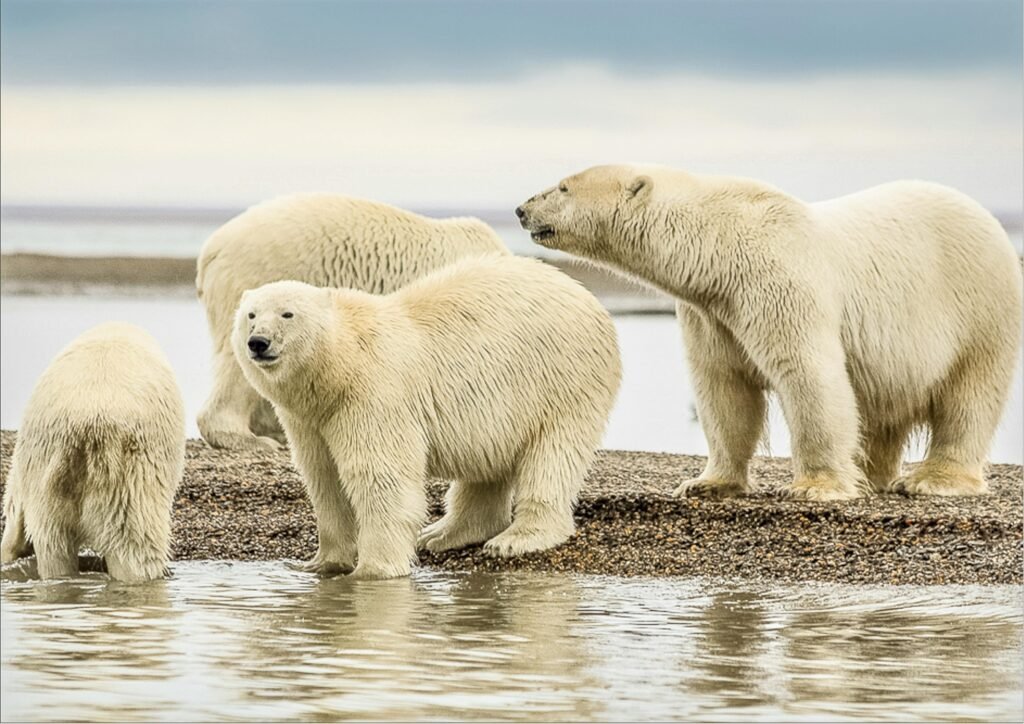
Table of Contents
Introduction To Why Small Population of Polar Bears are Left
Not many polar bears are left in this planet’s ecology mostly in their habitants of arctic region. The polar bear, a symbol of the Arctic environment, is an iconic figure in the field of animal protection. As climate change worsens, the sea ice that these magnificent creatures rely on for hunting and survival is fast disappearing, posing a serious threat to their survival. In this in-depth investigation, we look at the present state of polar bear populations around the world, the causes influencing their numbers, and the ongoing conservation efforts aimed at protecting these fragile creatures.
Polar Bear Biology and Habitat
Polar bears (Ursus maritimus) are highly specialised marine mammals that thrive in the Arctic. Their unique characteristics, such as a thick covering of insulating blubber and huge, powerful limbs, make them ideal for navigating the ice expanses of the arctic region. The sea ice provides as both a hunting field and a place to rest and raise their young.

Historical Population Trends
Historically, calculating the exact number of polar bears has been difficult due to their large and inaccessible environment. However, scientists have made tremendous progress in population monitoring by combining aerial surveys, satellite tracking, and genetic analysis. Overhunting posed a serious threat to polar bear populations in the 1960s and 1970s, prompting international conservation agreements that limited hunting and helped some species recover.
Current Population Estimates
According to the most recent estimations, polar bear populations are dispersed among 19 subpopulations in the Arctic. The International Union for Conservation of Nature (IUCN) estimates that the global population ranges between 22,000 and 31,000 individuals. While this range provides a basic perspective, specific subpopulations’ health and stability must be considered, as each faces unique problems.

Climate Change and Sea Ice Decline
The major threat to polar bear survival is the rapid loss of sea ice habitat due to climate change. Rising temperatures have reduced the extent and thickness of Arctic Sea ice, limiting the bears’ ability to hunt seals, their principal prey. This decline in sea ice also compels bears to travel longer distances, consuming more energy and increasing contacts with humans.
Effects of Climate Change on Seal Prey
Polar bears use sea ice as a platform to hunt seals, particularly ringed and bearded. These seals use the ice as a breeding and moulting platform. The diminishing and thinning of sea ice alters the timing and location of seal pupping, reducing bear hunting success rates. As a result, polar bears have extended periods of fasting, which reduces physical condition and reproductive effectiveness.
Polar Bears and Indigenous Communities
Climate change has far-reaching consequences for polar bears, affecting the livelihoods and customs of indigenous communities in the Arctic. Many indigenous peoples have coexisted with polar bears for millennia, relying on hunting and having a strong cultural bond with these spectacular creatures. As the bears confront greater challenges, so do the communities whose traditional activities are inextricably linked to the fate of the polar bear.
Conservation Strategies
Numerous conservation efforts have been implemented on both national and international levels in response to the polar bears’ dire plight. The five countries with polar bear populations—Canada, Denmark (Greenland), Norway, the United States, and Russia—have all played important roles in formulating and executing conservation strategies.
International Agreements and Conservation Initiatives
The most important international agreement for polar bear conservation is the 1973 Agreement on the Conservation of Polar Bears, which was signed by the five countries indicated above. This agreement limits hunting and requires the protection of polar bear habitat. Furthermore, organisations like the Polar Bear Specialist Group (PBSG) work together on research and conservation projects to monitor populations and address emerging risks.
Protected Areas and Conservation Reserves
Several Arctic governments have established protected areas and conservation reserves to protect crucial polar bear habitat. These locations serve as refuges for bears, allowing them to den, mate, and hunt without being disturbed by humans. Managing these regions is critical to ensure the bears’ long-term survival, especially when climate change alters their typical habitats.
Climate Change Mitigation
Recognising that climate change is the greatest threat to polar bears, conservation efforts are increasingly focused on worldwide attempts to prevent its effects. Advocating for reductions in greenhouse gas emissions and promoting sustainable practices on a global basis are critical components of conserving the sea ice habitat that polar bears require.
Technological Innovations in Conservation
Polar bear conservation relies heavily on innovative technologies. Satellite monitoring collars and drones give researchers with real-time data on polar bear movements and behaviour, allowing for the creation of more effective conservation initiatives. Remote sensing technologies also help monitor sea ice dynamics and estimate the effects of climate change on polar bear habitats.
Challenges and Controversies
Despite concerted attempts to protect polar bears, various problems and debates remain. Balancing human expansion, particularly in the Arctic, with the preservation of polar bear ecosystems necessitates complex negotiations. Disagreements between nations, economic interests, and varied levels of dedication to conservation can hamper coordinated efforts.
Conclusion
The future of polar bears is uncertain as climate change continues to transform the Arctic ecosystem. The loss of sea ice poses an existential threat to these iconic creatures, necessitating immediate and ongoing conservation efforts. While progress has been made through international collaboration and innovative solutions, the difficulties remain tough. As we traverse the complexity of polar bear conservation, it becomes evident that a healthy balance between human activity and the preservation of Arctic ecosystems is required to provide a future for these endangered giants of the north.

Very interesting topic, thank you for posting.Blog monetyze